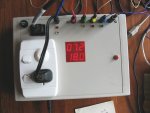This is a little device I built for my saltwater fish tank. Because the water is warm, fresh water evaporates, leaving the salt behind. Quite quickly, the salinity of the water can creep up above the sea-standard of 35ppt... which can stress the corals and other animals in the tank. You need to top up regularly with small amounts of fresh water, which I keep in a 100 litre drum.
This device has 2 sets of probes - 2 probes in the drum to measure a low-level condition, and 3 in the tank sump - one to measure high-level in the sump, and 2 to measure salinity. All probes are made of stainless steel - 1.6mm TIG welding rods - saltwater is brutal on electronics.
Each hour, the device checks the salinity of the tank with respect to the water temp (a DS18B20) and then switches on a tiny 240V pump for 7 seconds (pumps about 250ml of water) into the sump.
It makes an alarm fire if the fresh water drum runs out, or the sump is too high, or if salinity gets too high or low for some reason (32 - 37 ppt) or too hot/cold (29 - 24 deg C).
The various readings are displayed on 2 x 3 7-seg LED displays, driven by the MAX7219. The device features it's own little transformer for power, and has an LDR to dim the displays at night-time.
This is driven off a 28X picaxe.
This device has 2 sets of probes - 2 probes in the drum to measure a low-level condition, and 3 in the tank sump - one to measure high-level in the sump, and 2 to measure salinity. All probes are made of stainless steel - 1.6mm TIG welding rods - saltwater is brutal on electronics.
Each hour, the device checks the salinity of the tank with respect to the water temp (a DS18B20) and then switches on a tiny 240V pump for 7 seconds (pumps about 250ml of water) into the sump.
It makes an alarm fire if the fresh water drum runs out, or the sump is too high, or if salinity gets too high or low for some reason (32 - 37 ppt) or too hot/cold (29 - 24 deg C).
The various readings are displayed on 2 x 3 7-seg LED displays, driven by the MAX7219. The device features it's own little transformer for power, and has an LDR to dim the displays at night-time.
This is driven off a 28X picaxe.

